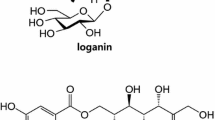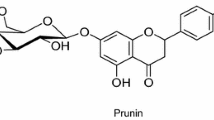Abstract
In the present study, we investigated the antidiabetic potential of fucoxanthin via the inhibition of rat lens aldose reductase (RLAR), human recombinant aldose reductase (HRAR), advanced glycation end-product (AGE) formation, protein tyrosine phosphatase 1B (PTP1B), and α-glucosidase. Fucoxanthin displayed potent inhibitory activity against AGE formation and HRAR and RLAR activity. In addition, fucoxanthin showed potent inhibitory activity against PTP1B. However, it did not show α-glucosidase inhibitory activity below 200 μM. In addition, our kinetic study revealed that fucoxanthin competitively inhibited RLAR, while it showed mixed-type inhibition against PTP1B. In order to confirm enzyme inhibition, we predicted the 3D structure of PTP1B using Autodock 4.0 to simulate the binding of fucoxanthin. Docking simulation results demonstrated that three residues of PTP1B (Phe30, Phe52, and Gly183) interact with the two hydroxyl groups of fucoxanthin. In addition, the binding energy was negative (−7.66 kcal/mol), indicating that the three hydrogen bonds may stabilize the open form of the enzyme and potentiate tighter binding to the active site of PTP1B, resulting in more effective PTP1B inhibition. The results of the present study therefore clearly demonstrate the promising potential of fucoxanthin as a therapeutic intervention for the management of diabetes as well as diabetes-associated complications, which could be explored further.




Similar content being viewed by others
References
American Diabetes Association (2005) Diagnosis and classification of diabetes mellitus. Diabetes Care 28:S37–S42
Wild S, Roglic G, Green A, Sicree R, King H (2004) Global prevalence of diabetes: estimates for the year 2000 and projections for 2030. Diabetes Care 27:1047–1053
de Groot M, Anderson R, Freedland KE, Clouse RE, Lustman PJ (2001) Association of depression and diabetes complications: a meta-analysis. Psychosom Med 63:619–630
Shaw JE, Sicree RA, Zimmet PZ (2010) Global estimates of the prevalence of diabetes for 2010 and 2030. Diabetes Res Clin Pract 87:4–14
El-Kabbani O, Ruiz F, Darmanin C, Chung RP (2004) Aldose reductase structures: implications for mechanism and inhibition. Cell Mol Life Sci 61:750–762
Brownlee M (2001) Biochemistry and molecular cell biology of diabetic complications. Nature 414:813–820
Laakso M (1999) Hyperglycemia and cardiovascular disease in type 2 diabetes. Diabetes 48:937–942
Bhandari MR, Anurakkun NJ, Hong G, Kawabata J (2008) α-Glucosidase and α-amylase inhibitory activities of Nepalese medicinal herb Pakhanbhed (Bergenia ciliata, Haw.). Food Chem 106:247–252
Zhang S, Zhang ZY (2007) PTP1B as a drug target: recent developments in PTP1B inhibitor discovery. Drug Discov Today 12:373–381
Barford D, Flint AJ, Tonks NK (1994) Crystal structure of human protein tyrosine phosphatase 1B. Science 263:1397–1404
Kamerlin SC, Rucker R, Boresch S (2007) A molecular dynamics study of WPD-loop flexibility in PTP1B. Biochem Biophys Res Commun 356:1011–1016
Wiesmann C, Barr KJ, Kung J, Zhu J, Erlanson DA, Shen W, Fahr BJ, Zhong M, Taylor L, Randall M, McDowell RS, Hansen SK (2004) Allosteric inhibition of protein tyrosine phosphatase 1B. Nat Struc Mol Biol 11:730–737
Matsuno T (2001) Aquatic animal carotenoids. Fish Sci 67:771–783
Miyashita K, Nishikawa S, Beppu F, Tsukui T, Abe M, Hosokawa M (2011) The allenic carotenoid fucoxanthin, a novel marine nutraceutical from brown seaweeds. J Sci Food Agric 91:1166–1174
D’Orazio N, Gemello E, Gammone MA, de Girolamo M, Ficoneri C, Riccioni G (2012) Fucoxanthin: a treasure from the sea. Mar Drugs 10:604–616
Maeda H, Hosokawa M, Sashima T, Miyashita K (2007) Dietary combination of fucoxanthin and fish oil attenuates the weight gain of white adipose tissue and decreases blood glucose in obese/diabetic KK-Ay mice. J Agric Food Chem 55:7701–7706
Maeda H, Tsukui T, Sashima T, Hosokawa M, Miyashita K (2008) Seaweed carotenoid, fucoxanthin, as a multi-functional nutrient. Asia Pac J Clin Nutr 17:196–199
Hosokawa M, Miyashita T, Nishikawa S, Emi S, Tsukui T, Beppu F, Okada T, Miyashita K (2010) Fucoxanthin regulates adipocytokine mRNA expression in white adipose tissue of diabetic/obese KK-Ay mice. Arch Biochem Biophys 504:17–25
Kotake-Nara E, Sugawara T, Nagao A (2005) Antiproliferative effect of neoxanthin and fucoxanthin on cultured cells. Fish Sci 71:459–461
Hosokawa M, Wanezaki S, Miyauchi K, Kurihara H, Kohno H, Kawabara J, Odashima S, Takahashi K (1999) Apoptosis-inducing effect of fucoxanthin on human leukemia cell line HL-60. Food Sci Technol Res 5:243–246
Hayman S, Kinoshita JH (1965) Isolation and properties of lens aldose reductase. J Biol Chem 240:877–882
Nishimura C, Yamaoka T, Mizutani M, Yamashita K, Akera T, Tanimoto T (1991) Purification and characterization of the recombinant human aldose reductase expressed in baculovirus system. Biochim Biophys Acta 1078:171–178
Vinson JA, Howard TB III (1996) Inhibition of protein glycation and advanced glycation end products by ascorbic acid and other vitamins and nutrients. J Nutr Biochem 7:659–663
Cui L, Na M, Oh H, Bae EY, Jeong DG, Ryu SE, Kim S, Kim BY, Oh WK, Ahn JS (2006) Protein tyrosine phosphatase 1B inhibitors from Morus root bark. Bioorg Med Chem Lett 16:1426–1429
Li T, Zhang XD, Song YW, Liu JW (2005) A microplate-based screening method for α-glucosidase inhibitors. Chin J Clin Pharmacol Ther 10:1128–1134
Lineweaver H, Burk D (1934) The determination of enzyme dissociation constants. J Am Chem Soc 56:658–666
Dixon M (1953) The determination of enzyme inhibitor constants. Biochem J 55:170–171
Cornish-Bowden A (1974) A simple graphical method for determining the inhibition constants of mixed, uncompetitive and non-competitive inhibitors. Biochem J 137:143–144
Peyrou J, Sternberg M (2006) Advanced glycation end products (AGEs): pharmacological inhibition in diabetes. Pathol Biol 54:405–419
Kaneko M, Bucciarelli M, Hwang YC, Lee L, Yan SF, Schmidt AM, Ramasamy R (2005) Aldose reductase and AGE-RAGE pathway: key players in myocardial ischemic injury. Ann NY Acad Sci 1043:702–709
de la Fuente JA, Manzanaro S, Martín MJ, de Quesada TG, Reymundo I, Luengo SM, Gago F (2003) Synthesis, activity, and molecular modeling studies of novel human aldose reductase inhibitors based on a marine natural product. J Med Chem 46:5208–5221
Tonks NKP (2003) TP1B: from the sidelines to the front lines! FEBS Lett 546:140–148
Lee S, Wang Q (2007) Recent development of small molecular specific inhibitor of protein tyrosine phosphatase 1B. Med Res Rev 27:553–573
Szczepankiewicz BG, Liu G, Hajduk PJ, Abad-Zapatero C, Pei Z, Xin Z, Lubben TH, Trevillyan JM, Stashko MA, Ballaron SJ, Liang H, Huang F, Hutchins CW, Fesik SW, Jirousek MR (2003) Discovery of a potent, selective protein tyrosine phosphatase 1B inhibitor using a linked-fragment strategy. J Am Chem Soc 125:4087–4096
Morris GM, Huey R, Lindstrom W, Sanner MF, Belew RK, Goodsell DS, Olson AJJ (2009) AutoDock4 and AutoDockTools4: automated docking with selective receptor flexibility. J Comput Chem 30:2785–2791
Hashimoto T, Ozaki Y, Taminato M, Das SK, Mizuno M, Yoshimura K, Maoka T, Kanazawa K (2009) The distribution and accumulation of fucoxanthin and its metabolites after oral administration in mice. Br J Nutr 102:242–248
Asai A, Sugawara T, Ono H, Nagao A (2004) Biotransformation of fucoxanthinol into amarouciaxanthin A in mice and HepG2 cells: formation and cytotoxicity of fucoxanthin metabolites. Drug Metab Dispos 32:205–211
Peng J, Yuan JP, Wu CF, Wang JH (2011) Fucoxanthin, a marine carotenoid present in brown seaweeds and diatoms: metabolism and bioactivities relevant to human health. Mar Drugs 9:1806–1828
Acknowledgments
This work was financially supported by the Ministry of Food, Agriculture, Forestry and Fisheries (20111001212-00) in the Republic of Korea.
Author information
Authors and Affiliations
Corresponding author
Rights and permissions
About this article
Cite this article
Jung, H.A., Islam, M.N., Lee, C.M. et al. Promising antidiabetic potential of fucoxanthin isolated from the edible brown algae Eisenia bicyclis and Undaria pinnatifida . Fish Sci 78, 1321–1329 (2012). https://doi.org/10.1007/s12562-012-0552-y
Received:
Accepted:
Published:
Issue Date:
DOI: https://doi.org/10.1007/s12562-012-0552-y




